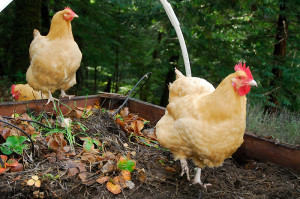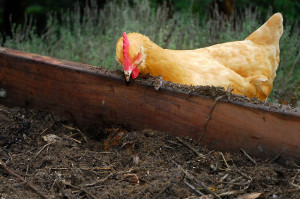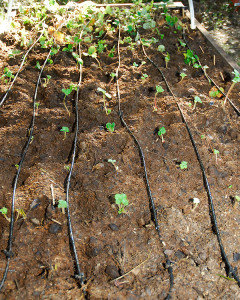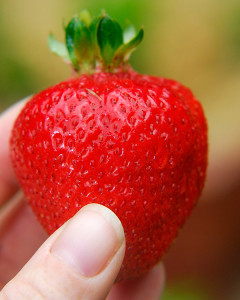I have a fondness for strawberries. I still remember, as a very small child, when I was given my first piece of garden to tend. It was all mine, to do anything I wanted with, and I didn’t have to share. In addition to the garden bed, I was gifted a dozen bare-root strawberry plants to plant in my new garden.
If I wanted strawberries though, first I’d have to plant them. Then I’d have to learn to take care of them. I would need to keep out the slugs, water the plants, pinch out the runners, and of course, pick the fruits when they were ripe. Due to runner production, it wasn’t long before that first dozen plants became 12-dozen, which resulted in a LOT of fruit after a couple of seasons! It’s probably fair to say that growing strawberries is what first got me hooked on gardening. It also helped me acquire a taste for strawberry-rhubarb pies…but I digress.
So last year I was a little disappointed in myself, because our strawberry bed in the garden was clearly suffering from a severe case of neglect. The plants were getting overgrown, the bird netting was rapidly deteriorating from the sun, and I’d neglected to top-dress the soil before the plants started to bloom.
Last year at least half of the berries were subsequently lost to a combination of slugs, birds, and squirrels, but as strawberries are entirely too good to waste, I’m determined that won’t happen again this year.
When we first installed the raised beds in the garden the strawberry box was the first to be planted. Each season we amended the soil, and maintained a layer of fresh straw under the forming fruits to keep them off the damp soil beneath. The plants have grown well, and multiplied over the last few seasons, but this season it was clear this bed really needed a complete overhaul if we wanted to continue to get any quantity of fruit.
The bed was getting quite weedy after our December rains, and the plants had a lot of dead leaves that needed to be trimmed. Not to mention the soil in this raised bed was exhausted, and needed to be replenished.
At first I just intended to work the existing bed over, but this bed is quite exposed at the edge of our south slope, and it can be challenging to protect the plants from the blistering west sun during runs of excessively warm weather. So, as peppers or tomatoes would probably be better suited to this location, I decided, as we have a few empty beds awaiting spring planting, to move the entire strawberry collection to a new bed.
Most commercial growers in this area treat strawberries as an annual crop. The advantage to that is in a garden like ours we could simply incorporate the strawberries into a standard rotation scheme. Like most gardeners though, we treat our strawberry plants as perennials. We leave them in the ground year over year, and only cull older, and/or less productive, plants.
Relocating the strawberries would mean I had to dig up every single plant, which was more time consuming than I originally intended for this project, but the advantage was I could site the plants in a better location, and by moving the plants, reduce the potential for build up of diseases in the soil. By culling out the older, less productive plants, and reworking the soil, the reward should be that our fruit yields will increase over the next couple of seasons.
First I pulled out the plants in the existing bed, sorting them by variety into large empty pots, that were labeled. Dead leaves were trimmed off, and only healthy plants with strong root systems were saved. Damaged or spindly plants were composted.
Of course, during this entire process I was stirring up all sorts of delectable chicken treats, so it wasn’t too long before our resident tilling-and-pest-control crew reported for duty.
Once all the plants were processed, it was time to replenish the beds with some fresh compost.
Between the turkeys, chickens, and goats, we have no shortage of compostable material for our gardens. However, we also augment our own farm-generated compost with material from our local equestrian center a few times a year.
Once well composted, this is far better than any compost you’re likely to find in a bag. It’s much cheaper than buying compost, and has virtually eliminated our use of supplemental fertilizers too!
Finally, with the bed prepared, it was time to replant. At the end of the day I’d planted a total of 84 strawberry plants, including two new varieties to the farm this year.
We have high hopes for this berry bed this spring!
We’ve recently been asked by a few of our readers which strawberry variety they should plant, or why don’t their plants produce a large crop? When selecting strawberries it’s important to keep in mind that not all strawberries are created equal. Some are better adapted to growing in a particular region, some are more flavorful than others, some keep better than others.
In regards to fruit production, the most important thing to know about strawberries is whether they are June-bearing, day-neutral, or everbearing varieties. Note that some retailers treat day-neutral and everbearing varieties the same, but they are in fact a little different.
June-bearing: These plants produce a single large crop once per year, usually in the early summer, and the fruits on average tend to be larger than day-neutral varieties
Day-neutral: these varieties are at their peak production in early summer, but then continue to sporadically produce fruit through to fall, as late as October in milder climates. Day-neutral types are particularly well adapated to growing in Northern California, but plants should be replaced every 2-3 years to maintain production.
Everbearing: this term is something of a misnomer, in that everbearing strawberries tend to produce two distinct flushes of fruit per year. One in early summer, another in the fall, and there may be a few scant berries in between. Crops are usually smaller than June-bearing varieties though.
The chart below summarizes some of the most commonly grown strawberry cultivars by production type.
Here’s a printable PDF version of our reference chart for anyone that might find it useful.
In the home garden knowing whether a strawberry type is June-bearing, day-neutral, or everbearing, helps when choosing an assortment of plants to ensure berry production throughout the growing season. However, if you make jam, or pies, you might prefer to have more of the crop ready all at once, and elect to plant predominantly June-bearing varieties.
You can think of strawberries a little like tomatoes, where the June-bearers are the determinate type, the all-at-once paste tomatoes. Whereas the day-neutral and everbearing berries are more like the indeterminate tomatoes. You get an initial crop, and the plants continue to produce through the remainder of the season.
Up until this season we’ve been primarily growing ‘Seascape’ (day-neutral), and ‘Eversweet’ (everbearing) strawberries. Both are well adapted to growing in this region.
Although production has been acceptable throughout the season, we’ve felt the initial spring crop has been somewhat lacking in volume. This year we’ve added two new varieties, ‘Albion’ (day-neutral), and ‘Sequoia’ (June-bearing). The addition of June-bearing ‘Sequoia’ should help to give us a more robust crop of spring berries, along with the first crop of ‘Eversweet’. Then we’ll see some mid-season fruits with day-neutral ‘Seascape’ and ‘Albion’. Then a second crop of ‘Eversweet’ rounding out the season with a final flush of fruit in September-October.
So, with the soils recharged, the beds replanted, now we wait for berry season to get into full swing. It won’t be long before the first blooms appear…
…and then by late spring, we hope to be harvesting more of these!
Now my next task is to add some compost to the rhubarb patch! Do you grow strawberries? Do you have a favorite variety? What’s your favorite way to use them?

























Someone had told me that one type doesn’t send out trailers like the others. I can’t remember which though. Do you know?
Generally speaking I think the June-bearers put out more runners than day-neutrals, or everbearers. We grew San Andreas for a while, a day-neutral, and got very few runners. There are exceptions though. I know that Quinault throws quite a few for an everbearer, and in our garden Eversweet has had no trouble propagating itself either!
How often do you replace the plants?
Catharine, day-neutrals should be replaced every 2-3 years. They do tend to decline in production more quickly than the other types. With the June-bearers and everbearers, they can usually go a little longer. 3-5 years, depending on variety and growing conditions. If they’re setting lots of runners, you can plant the runners in another bed in the fall as replacements, then you always have some young vigorous plants in the garden. My first plants in England were June-bearers, and set a lot of runners each fall. I never had to buy plants again!
I’m so sorry to say that I broke down and bought strawberries at the grocery store yesterday for the kids. I never buy strawberries and tomatoes during the winter, because there’s just no comparison to homegrown. Still–my kiddos were happy. We have three different beds in our gardens for strawberries, and I can’t wait for spring! I also grow fraise des bois throughout the gardens, too–so tiny, but what an amazingly delicious little berry!
We have woodland strawberries that grow like weeds here! I wouldn’t say we ‘grow’ them per se, the grow themselves 😉 The goats love the new leaves in spring, and a lot of the tiny berries get eaten by our poultry. Not sure I’ve ever eaten one of the berries myself, I don’t get a chance!
You’re killin me, Clare! Those strawberries look so good. I planted my first full bed in the Fall (Sequoias and Quinaults). I’m so looking forward to them. Good luck with the new strawberry patch.
It wasn’t easy putting this post together, staring at the photos of strawberries from past seasons 😛 I can’t wait though, and our recent warm weather has me very impatient for spring! I haven’t grown Quinault in a long time, so can’t wait to see how yours grow!
Great post! Thanks for the reminder to go and take care of my strawberry plants. They definitely need some TLC. Mine are June bearing but have no idea what variety. I’ll have to look back to see if I have the tag or wrote it down in my journal.
I think my problem last year was that I ‘thought’ about tending to my strawberry plants, in maybe late December, and then I blinked, built a barn, got some goats, and it was April already! I’m trying to pay better attention to the calendar this year…we’ll see how long that lasts!
I expect any new varieties that we plant here are likely to be June bearers. For preserving, and baking, sometimes it’s really handy to have a lot of fruit ready all at once. The dribs-and-drabs are great for cereal and yogurt, but not so good when you NEED a lot at once for pie. And we all NEED pie 😛
Thanks for the chart, Clare I can sure use it in the nursery when ordering. The photo of the strawberry flower is lovely. Do you do anything to keep the strawberries from touching the ground? And do you think strawberries would get enough soil to grow if planted in rain gutters like you see some places?
The photo of the strawberry flower is lovely.
Once the plants begin to set fruit, I put a layer of clean, dry straw on the surface of the soil. That way the berries rest on the straw, rather than on the damp soil. Usually by then the bulk of our rains are over, but if you’re still getting rain, you can just refresh the straw periodically through the fruiting season.
I’m skeptical about rain gutters, and this is why. When I was confined to apartment living for a while, I used to use those ‘strawberry pots’, the clay ones, with multiple holes in them? The plants would grow, some, they’d fruit, some, but they never performed they way they do in the ground, or grown in raised beds. Most of the plants I pulled this week had some seriously hefty roots, at least the length of my hand, and I just don’t think that gutters, and strawberry pots, provide enough room, or enough soil. At least not enough to perform their best, unless you want to be a slave to synthetic fertilizers, and the hose 😉
I hope you get tons of strawberries this year! It looks so nice and tidy. I had strawberries growing under the fig tree and used to get some, but the tree has shaded them out too much now.
I saw part of what looks like pvc pipe over the beds, is that what you put the netting over?
I need to figure out how to keep our blueberries safe from chickens and other birds.
Catherine, look through our raised bed post. If you scroll down about 2/3 down that page there are two photos that show how we installed the pvc hoops for the beds. The hoops themselves can be removed (for installing something like tomato cages or cucumber frames), or we use them for row covers in winter, or for supporting netting, or shade cloth, the rest of the season. I LOVE them, and they get a lot of use, and are cheap/easy to install.
For netting I used to use the typical 1/2″ plastic mesh raspberry netting, but it breaks down too quickly, and the squirrels just tear through it. I just ordered some Protek Net through Purple Mountain Organics as an alternative. I’ll let you know how it works out!
So many healthy little strawberry plants! I planted strawberries for the first time ever last year, can you believe it. I think I had 6 plants and now I have about 20. All Sequoia and the handful of berries I got were great even though my beds were brand new and undernourished. But I have compost this year so I’ll just have to make myself get out there and use it like you!
That’s what I love about June-bearers, you never have a shortage of replacement plants! Often the first season they won’t produce a lot of fruit, but I expect you’ll get a lot more this season! 🙂
How perfect that you’ve written this post now. I was just promising myself this morning that next season I will embrace the strawberry patch that I completely neglected this spring/summer and get serious about growing them successfully! Thanks for the great tips!
Glad I’m not the only won’t that neglected the strawberries last season. If they’re happy, they really don’t need much attention, but trimming out old growth, and adding a hefty dose of compost, can definitely work wonders!
I don’t grow strawberries, but I have often thought of putting in a strawberry bed. The “where” though, has never presented itself – yet. I am amazed at the size of your strawberries, and there is a lot of information in this post. Maybe I will find the right spot this year! That compost looks beautiful!
We’ve had some real monster fruits, when I’ve been on top strawberry bed maintenance 😉 I’m happy with how our compost has been doing too. Sometimes that pile emits so much steam, it almost looks like smoke, especially on a cold morning. It’s fooled me more than once!
Clare you remind me that i have neglected mine. I finally let them grow against the side of the house as a groundcover although I really need a bed for them as I love them. So I will have to figure this out…for now they grow as a groundcover on the side of the house. At least this year I can thin and compost them for the critters who get most of them.
It can be challenging to protect the crop from everything else that wants to steal it. Here it’s mostly birds, and the standard raspberry netting isn’t always good enough to keep them off either! I can’t blame them though, the fruits are so tasty!
I have a raised strawberry bed that is very productive. However, every time a runner rooted in the straw paths around it, I said oh more strawberries I really don’t need that path. Now most of raised vegetable gardens are strawberries and I don’t know where to start. I wish i could send you a photo because it’s really pretty funny. I am not sure if I thanked you for the beautiful Christmas card of “the girls”. I just took it down yesterday and now it’s on my desk.
That’s the trouble with strawberries, when they’re very happy where they’re growing, they can take over. Here I think our lack of summer rain helps to keep them from spreading too far and wide, but in England I remember them marching across the garden quite freely. So glad you got the card with the girls! 🙂
I have been following your blog for sometime. I have it listed on my sidebar. This was a wonderful post. I especially loved your clean-up brigade,lol. So cute. I just wanted to post that I am also Sequioa Strawberries. I read last yr that you should mow over strawberries above the crown in late fall to increase production. We shall see this yr.
Our clean-up brigade is very efficient, and they love to help us when we’re turning over the garden beds. Now, if I could teach them how to plant things, instead of ripping them up 😛
Your new strawberry bed looks very promising! I am sure the chickens enjoyed their part in the work. I have tried to grow strawberries several times, as I love them so, but each time they suffered from some sort of virus, becoming stunted and malformed. Strawberries grow well in my part of the country, and I have enjoyed trips to a you-pick-um farm not too far away. My strawberry failure is a real frustration. Maybe I just need some of your wonderful compost!
Some strawberries are more disease resistant than others. Good soil, that drains well, can definitely help too. The June-bearer ‘Albritton’ might be a good choice for where you are.
I have been thinking about this very same task. Only 2 years after planting my first strawberries the bed has become a disaster. Strawberry plants squeezed together so thickly I wonder if I’ll get any berries this season. I’ll be digging the bed over completely this year after harvest and trying to spread the plants out a bit more. I love strawberries and we can never have enough but they sure take a bit of work to keep under control.
They do take a little work to be their best, but once the berries start to ripen, it all becomes worthwhile!
Oh, those strawberries! Aren’t they just shouting “Spring!” Beautiful pics Clare, my mouth is watering. We have raised boxes for our strawberries but they are such free spirits, it seems every summer they want out of the boxes and head for the trails. Keeps me busy. I do take out the old ladies each Spring and let the little ones fulfill the measure of their creation. It keeps the crop vibrant and healthy, that and the compost we throw in the boxes in Fall. As for harvesting, we have to keep ahead of the birds AND the little neighbor boys. Both are cute, so we don’t mind sharing… much.
We’re challenged with birds. I wish they’d take one, and not a bite out of lots of them at once 😉 The other challenge is the farmers…sometimes they (we) devour them before they have any hope of making it to the house! 😀
Clare, This looks like it was a lot of work, but you will reap your delicious reward in a few months. I didn’t like strawberries as a child (I was the one who requested my strawberry shortcake ‘without the strawberries’ :-)) and only got hooked on them when I bought my property in Maine and found wild strawberries (Fragaria virginiana) growing profusely. The berries are tiny, but their flavor is intense. Occasionally, cedar waxwings will swoop in and eat much of the crop, but I don’t mind sharing with them in exchange for their beautiful presence. I am more likely to begrudge sharing with the chipmunks, who take way more than their share and then add insult to injury by leaving the hulls piled up on the stairs beside my prime strawberry patch.